Search results for 'university database cis'
-

PRG 421 Week 3 Learning Team Fundraiser Initial program
$12.00Learning Team Instructions Fundraiser Program
Learn More
A city is sponsoring a run to support local charities and would like an application to track the pledges. The result will be a database that holds data on individuals, total pledges obtained, and the charity for which the donation is designated.
Design and implement a GUI-based program to accept a participant’s name, the amount pledged, and the designated charity’s name. The program will store these data for later retrieval.
PRG 421 Week 3 Learning Team Initial program
Create a GUI-based program to accept name of donor, name of charity, and amount of pledge from the user.
Display a list of entries in a JTextArea or JTable.
Submit the .java source file for this program. -

PRG 421 Week 4 Learning Team Fundraiser Program Instructions Add a Data File
$12.00Learning Team Instructions Fundraiser Program
Learn More
A city is sponsoring a run to support local charities and would like an application to track the pledges. The result will be a database that holds data on individuals, total pledges obtained, and the charity for which the donation is designated.
Design and implement a GUI-based program to accept a participant’s name, the amount pledged, and the designated charity’s name. The program will store these data for later retrieval.
PRG 421 Week 4 Learning Team Instructions Add a Data File
Modify the program you created in Week Three to write the data—name, amount, and charity—into a sequential data file.
Implement a capability of reading what is in the existing data file and displaying it in the text area.
Submit the .java source file for the program. -

PRG 421 Week 5 Learning Team Fundraiser Program Connect to a Database
$15.00Learning Team Instructions Fundraiser Program
Learn More
A city is sponsoring a run to support local charities and would like an application to track the pledges. The result will be a database that holds data on individuals, total pledges obtained, and the charity for which the donation is designated.
Design and implement a GUI-based program to accept a participant’s name, the amount pledged, and the designated charity’s name. The program will store these data for later retrieval.
PRG 421 Week 5 Learning Team Connect to a Database
Write a program to create a database from the data in the sequential file you created in Week Four.
Modify the GUI to connect to this database and add entries to it and read entries from it. Entries read from the database should be displayed in the JTextArea or JTable.
Test and debug this final program.
Submit the .java source file or files. -

CIS355A iLab 1 ShowEscapeSequences Circle and PracticeArithmeticOperators Programs
$15.00CIS355A iLab 1 ShowEscapeSequences Circle and PracticeArithmeticOperators Programs
In this lab you will learn how to use the Java Software Development Kit (SDK) with the Eclipse programming tool. In addition, you will create three simple Java programs.
Deliverables
Program files for each of the following three programs.
1. ShowEscapeSequences.java
2. Circle.java
3. PracticeArithmeticOperators.java
At the beginning of ALL your programs, put a comment box that includes the program name, your name, and a brief description of the program.iLAB STEPS
STEP 1: ShowEscapeSequences (10 points)
Write a Java program named ShowEscapeSequences.java that displays the following.
I really like
CIS355A
"Business Application Programming with Lab using JAVA"STEP 2: Circle (15 points)
Write an application called Circle.java that inputs from the user the radius of a circle as an integer and prints the circle’s diameter, circumference, and area. Use the example program and GUI technique message dialog box shown in the Week 1 Lecture.
Use the following formulas.
diameter = 2 * radius
circumference = 2 * Math.PI * radius
area = Math.PI * radius * radius
Use the predefined constant Math.PI for your calculation. This constant is more precise than the value 3.14159. Class Math is defined in the java.lang package so you do not need to import it.STEP 3: PracticeArithmeticOperators (15 points)
Learn More
Write an application called PracticeArithmeticOperators.java that asks the user to enter two numbers. The program is to convert these numbers from String to type int and then print in a tabular format the sum, the difference, the product, and the quotient of the two numbers entered. Use the example program shown in the Week 1 Lecture. For example, if the user enters 25 and 5, the following should be displayed.
Operation Result
25 + 5 30
25 – 5 20
25 * 5 125
25 / 5 5 -
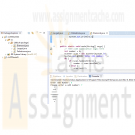
CIS355A iLab 2 Largest Palindrome and Diamond Programs
$15.00CIS355A iLab 2 Largest Palindrome and Diamond Programs
In this lab you will create programs that use control structures and user-defined methods.
Deliverables
Program files for each of the following three programs.
1. Largest
2. Palindrome
3. Diamond
At the beginning of ALL your programs, put a comment box that includes the program name, your name, and a brief description of the program.iLAB STEPS
STEP 1: Largest (10 points)
Write a Java application program called Largest.java that inputs a series of 10 single-digit numbers and determines and prints the largest of the numbers. Except main() method, no other user-defined method is required. Your program should use at least the following three variables
1. counter: A counter to count to 10 (that is, to keep track of how many numbers have been input and to determine when all 10 numbers have been processed);
2. number: The current digit input to the program; and
3. largest: The largest number found so far.
When each number is entered, make sure it is a single digit number, that is 0 to 9.STEP 2: Palindrome (15 points)
A palindrome is a sequence of characters that reads the same backward as forward. For example, each of the following five-digit integers is a palindrome: 12321, 55555, 45554, and 11611. Write an application called Palindrome.java that asks the user to enter in a five-digit integer and determines whether it is a palindrome. If the number is not five digits long, display an error message dialog indicating the problem to the user. When the user dismisses the error dialog, allow the user to enter a new value.
Your program will have the following four methods
1. main() method, which controls the execution of the program;
2. retrieveInput() method, which prompts and retrieves the input values;
3. check() method, which determines whether it is a palindrome; and
4. display() method, which displays the result.STEP 3: Diamond (15 points)
Learn More
Write a program called Diamond.java that uses a method diamondOfAsterisks() that displays a diamond (the row number of a diamond must be odd) of asterisks whose row is specified in an integer parameter row. For example, if the user enters a 7, then the diamond will have seven rows and the method will display the pattern of asterisks. Below is an example of the diamond displayed when 7 is entered.
*
***
*****
*******
*****
***
* -
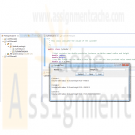
CIS355A iLab 3 Cylinder and Date Java Programs
$15.00CIS355A iLab 3 Cylinder and Date Java Programs
In This lab you will create two programs that use classes and methods.
Deliverables
Program files for each of the following two programs
1. Cylinder
2. DateiLAB STEPS
STEP 1: Cylinder
Create a class called Cylinder.java that contains two double-precision instance variables named radius and height. The class should include a constructor that initializes the radius and height variables. Also, you need a class method named volume() that returns the volume of a Cylinder object. The volume of a cylinder is given by its radius squared times its height times Pi (radius * radius * height * Math.PI). You can either use the value 3.1416 for Pi or use the Java provided value named Math.PI.
Write a class called CylinderTest.java and declare an array of three Cylinder objects to call the methods you declared in the Cylinder class. Make sure that all class methods are called from main(). Have main() display the value returned by volume() and verify the returned value by hand calculations (paper/pencil). Prompt the user to enter the values for the radius and height of each Cylinder object in the array.
Learn More
STEP 2: Date (20 points)
Create a program called Date.java to perform error-checking on the initial values, for instance: fields month, day, and year. Also, provide a method nextDay() to increment the day by one. The Date object should always remain in a consistent state.
Write a program called DateTest.java that prompts the user to enter the month, day, and year as numeric values. This program then creates a Date object using the Date class you just created and tests the nextDay() method. This can be done in a loop of 40 iterations: the Date object calls the nextDay() method and prints the date during each iteration of the loop. This loop is to illustrate that the nextDay() method works correctly. Test the following cases:
a. Incrementing into the next month, for example, use date: 02/28/2011
b. Incrementing into the next year, for example, use date: 11/27/2011
c. Incrementing into the next month in a leap year, for example, use date: 02/28/2012
Sample Program Output:
Checking increment
Date object constructor for date 11/27/2011
Incremented Date:11/28/2011
Incremented Date:11/29/2011
Incremented Date:11/30/2011
Day 31 invalid. Set to day 1.
Incremented Date:12/1/2011
Incremented Date:12/2/2011
...
Incremented Date:12/30/2011
Incremented Date:12/31/2011
Day 32 invalid. Set to day 1.
Incremented Date:1/1/2012
Incremented Date:1/2/2012
Incremented Date:1/3/2012
Incremented Date:1/4/2012
Incremented Date:1/5/2012
Incremented Date:1/6/2012 -
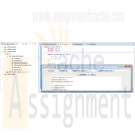
CIS355A iLab 4 InheritanceTest DayGui and OfficeAreaCalculator Java Programs
$15.00CIS355A iLab 4 InheritanceTest DayGui and OfficeAreaCalculator Java Programs
In this lab, you will create one project that uses inheritance and two simple Graphical User Interfaces (GUI) programs.
Deliverables
Program files for each of the following three programs
1. InheritanceTest
2. DayGui
3. OfficeAreaCalculatoriLAB STEPS
STEP 1: InheritanceTest (20 points)
Write a program called InheritanceTest.java to support an inheritance hierarchy for class Point-Square-Cube. Use Point as the superclass of the hierarchy. Specify the instance variables and methods for each class. The private variable of Point should be the x-y coordinates. The private data of Square should be the sideLength. The private data of Cube should be depth. Each class must provide applicable accessor, mutator, and toString() methods for manipulating private variables of each corresponding class. In addition, the Square class must provide the area() and perimeter() methods. The Cube must provide the area() and volume() methods.
Write a program that instantiates objects of your classes, ask the user to enter the value for x, y, and sideLength, test all instance methods and outputs of each object’s perimeter, area, and volume when appropriate.STEP 2: DayGui (10 points)
Write a program called DayGui.java that creates a GUI having the following properties
Object Property Setting
JFrame Name Caption Layout mainFrame Messages FlowLayout
JButton Name Caption Mnemonic cmdGood Good G
JButton Name Caption Mnemonic cmdBad Bad B
Add individual event handlers to your program so that when a user clicks the Good button, the message "Today is a good day!" appears in a dialog box, and when the Bad button is clicked, the message "I'm having a bad day today!" is displayed. The following tutorial shows you much of the code solution. Feel free to use the tutorial, but make changes so that you are not simply copying the tutorial code for your entire solution. To make this different from the tutorial, change the colors of the buttons and panel. Also, add this application to a tabbed pane along with the program you will complete in the next step, Step 3. The following tutorials will likely be useful as you work to complete this step:
• JTabbedPane
• Tutorial to Write Your First GUISTEP 3: OfficeAreaCalculator (10 points)
Learn More
Write a program called OfficeAreaCalculator.java that displays the following prompts using two label components
• Enter the length of the office:
• Enter the width of the office:
Have your program accept the user input in two text fields. When a button is clicked, your program should calculate the area of the office and display the area in a text field with a label of Area. This display should be cleared whenever the input text fields receive the focus. A second button should be provided to terminate the application (Exit button).
The following tutorial shows you much of the code solution. Feel free to use the tutorial, but make changes so that you are not simply copying the tutorial code for your entire solution. To make this different from the tutorial, change the colors of the panel. Also, add this application to the same tabbed pane (see the JTabbedPane tutorial) as the application you built in Step 2, the DayGui application.
• Office Area Calculator Tutorial -

CIS355A iLab 5 GuessGame and Text File I/O Java Programs
$15.00CIS355A iLab 5 GuessGame and Text File I/O Java Programs
In this lab you will create a single program that creates and reads a sequential file. All outputs must be GUI-based without using JOptionPane.
Deliverables
Program files for each of the following two programs
1. GuessGame
2. Text File I/OiLAB STEPS
STEP 1: GuessGame
Write a program named GuessGame.java that plays the game “guess the number” as follows: Your program chooses the number to be guessed by selecting an integer at random in the range 1–1000. The program then displays the following in a label.
I have a number between 1 and 1000 -- can you guess my number?
Please enter your guess: ____________________
A JTextField should be used to input the guess. A JButton must be provided to allow the user to press each time a guess is entered. As each guess is input, the background color should change to either red or blue. Red indicates that the user is getting warmer, and blue indicates that the user is getting colder. A JLabel should display either Too High or Too Low to help the user zero in on the correct answer. When the user gets the correct answer, Correct! should be displayed, and the JTextField used for input should be cleared and changed to be uneditable. Also, a JButton should be provided to allow the user to play the game again. When the New Game JButton is clicked, a new random number should be generated and the input JTextField changed to be editable. A JButton must be provided to allow the user to exit the application. Also provide a count of the number of guesses the user entered when the correct number is guessed.STEP 2: Text File I/O (20 points)
Learn More
Write a program called TextFileIO.java to create a file named numbers.dat. Then create an algorithm that writes all even numbered integers from 1 to 100, separated by a comma. After the file has been created, close and reopen the file and display the results to the screen. After the results have been displayed append the odd number integers from 1 to 100, separated by a comma to the end of the file. Reopen the file and display the results. The contents of the file should be the even numbers from 1 to 100 separated by a comma followed by the odd number from 1 to 100 separated by a comma. The output of this program would be something like the following
2,4,6,8,10,12,14,……,98,100
2,4,6,8,10,12,14,……,98,100,1,3,5,7,9,……..97,99 -
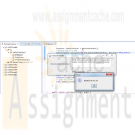
CIS355A iLab 6 Index Index2 and ThreeArrayLists Java Programs
$15.00CIS355A iLab 6 Index Index2 and ThreeArrayLists Java Programs
In this lab you will create three programs
Index.java
Index2.java
ThreeArrayLists.javaProgram files for each of the following three programs
Index
Index2
ThreeArrayListsiLAB STEPS
STEP 1: Index (10 points)
Write a Java GUI application called Index.java that inputs several lines of text and a search character and uses String method indexOf to determine the number of occurrences of the character in the text. This program is not case sensitive and both upper and lower case must be counted for.
Sample Program output: View Output DescriptionSTEP 2: Index2 (10 points)
Write a Java GUI application Index2.java based on the program in Step 1 that inputs several lines of text and uses String method indexOf to determine the total number of occurrences of each letter of the alphabet in the text. Uppercase and lowercase letters should be counted together. Store the totals for each letter in an array, and print the values in tabular format after the totals have been determined.
Sample Program output: View Output DescriptionSTEP 3: ThreeArrayLists (20 points)
Learn More
Write a program called ThreeArrayLists.java that declares three ArrayList objects referenced by the objects named priceList, quantityList, and amountList. Each ArrayList should be declared in main() and should be capable of holding a minimum of 10 double-precision numbers.
• The numbers that should be stored in priceList are 10.62, 14.89, 13.21, 16.55, 18.62, 9.47, 6.58, 18.32, 12.15, 3.98.
• The numbers that should be stored in quantityList are 4, 8.5, 6, 7.35, 9, 15.3, 3, 5.4, 2.9 4.8.
Your program should pass object references to these three ArrayList objects to a method named extend(), which should calculate the elements in the amountList ArrayList as the product of the corresponding elements in the priceList and quantityList ArrayList, for example, amountList.add(priceList.get(i) * quantityList.get(i)).
After extend() has put values into the amountList ArrayList object, create a method that displays the results of all three lists. Appropriate formatting techniques need to be used to produce a formatted output.
Tip: It is a good idea to create two arrays of type double to store the values that correspond to the price and the values that correspond to the quantity, for example:
double[] PRICE_ARRAY = { 10.62, 14.89, 13.21, 16.55, 18.62, 9.47, 6.58, 18.32, 12.15, 3.98 };
double[] QUANTITY_ARRAY = { 4.0, 8.5, 6.0, 7.35, 9.0, 15.3, 3.0, 5.4, 2.9, 4.8 };
Sample program output:
1) 10.62 * 4.0 = 42.48
2) 14.89 * 8.5 = 126.56
3) 13.21 * 6.0 = 79.26
4) 16.55 * 7.35 = 121.64
5) 18.62 * 9.0 = 167.58
6) 9.47 * 15.3 = 144.89
7) 6.58 * 3.0 = 19.74
8) 18.32 * 5.4 = 98.93
9) 12.15 * 2.9 = 35.24
10) 3.98 * 4.8 = 19.1 -
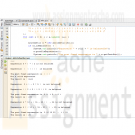
COP3804 Assignment 4 Infix to Postfix
$15.00COP3804 Assignment 4 Infix to Postfix
The concept of stack is extremely important in computer science and is used in a wide variety of problems. This assignment requires you to write a program that can be used to evaluate ordinary arithmetic expressions that contains any of the five arithmetic operators (+, -, *, /, %).
This exercise requires three distinct steps, namely:
1. Verify that the infix arithmetic expression (the original expression), that may contain regular parentheses, is properly formed as far as parentheses are concerned.
2. If the parenthesized expression is properly formed, convert the expression from an infix expression to its equivalent postfix expression, called Reverse Polish Notation (RPN) named after the Polish Mathematician J. Lukasiewics.
3. Evaluate the postfix expression, and print the result.Step 1 - Verify that the expression
Given an arithmetic expression, called an infixed expression, to verify that it is properly formed as far as parentheses are concerned, do the following:
• Create an empty stack to hold left parenthesis ONLY.
• Scanned the arithmetic expression from left to right, one character at a time.
• While there are more characters in the arithmetic expression
{
If the character is a left parenthesis ‘(‘, push it on to the stack. However if the character is a right parenthesis, ‘)’, visit the stack and pop the top element from off the stack.
}
• If the stack contains any element at the end of reading the arithmetic expression, then the expression was not properly formed.Step 2 - Convert infixed expression to postfix
Given that an arithmetic expression is properly form with respect to parentheses, do the following:
• Create an empty stack to hold any arithmetic operators and left parenthesis, ONLY.
• A string to contain the postfix expression – the output from this conversion.
• Scan the arithmetic expression from left to right.
• While the are more symbols in the arithmetic expression,
{
After a symbol is scanned, there are four (4) basic rules to observed and apply accordingly:
1. If the symbol is an operand (a number), write it to the output string.
2. If the symbol is an operator and if the stack is empty, push the symbol on the stack.
Otherwise, if the symbol is either ‘(‘ or ‘)’, check for the following conditions:
If the symbol is ‘(‘, push on to the stack,
Otherwise
If the symbol is ‘)’
{
Pop everything from the operator stack down to the first ‘(‘. Write each item
popped from the stack to the output string. Do not write the item ‘)’. Discard it.
}
3. If the symbol scanned is an arithmetic operator, check for the following and apply accordingly:
If the operator on the top of the stack has higher or equal precedence, that operator is popped from off the stack, and is written to the to the output string. This process is continues until one of two things happen:
(a) Either the first ‘(‘ is encountered. When this occurs, the ‘(‘ is removed from the stack and is discarded, and the recently scanned symbol is placed on the stack
OR
(b) The operator on the stack has lower precedence than the one just scanned. When this situation arises, the recently scanned symbol is pushed onto the stack.
}
4. After the arithmetic expression is exhausted, any operator is remaining on the stack must be popped from off and is written to the output string.Step 3 - Evaluate the post fixed expression
Initialize an empty stack.
While there are more symbols in the postfix string
{
? If the token is an operand, push it onto the stack.
? If the token is an operator
{
Pop the two topmost values from the stack, and store them in the order t1, the topmost, and t2 the second value.
Calculate the partial result in the following order t2 operator t1
Push the result of this calculation onto the stack.
NOTE: If the stack does not have two operands, a malformed postfix expression has occurred, and evaluation should be terminated.
}
}
When the end of the input string is encountered, the result of the expression is popped from the stack.
NOTE: If the stack is empty or if it has more than one operand remaining, the result is unreliable.Extend this algorithm to include square brackets and curly braces. For example, expressions of the following kind should be considered
2 + { 2 * ( 10 – 4 ) / [ { 4 * 2 / ( 3 + 4) } + 2 ] – 9 }
2 + } 2 * ( 10 – 4 ) / [ { 4 * 2 / ( 3 + 4) } + 2 ] – 9 {Implement the above two algorithms for the following binary operators: addition +, subtraction -, multiplication *, division /, and modulus operation %. All operations are integer operations. To keep things simple, place at least one blank space between each token in the input string.
Use the following code below as your Main Test class:
class RPN
{
public static void main(String[] arg)
{
String s[] = {"5 + ) * ( 2",
" ( { [ } ) ] ",
" 2 + ] - 3 * 5 [ ",
"[( 2 + 3 ) * 5] * 8 ",
"5 * 10 + ( 15 - 20 ) ) - 25",
"5 * { 10 + ( 15 - 20 ) } - 25",
" 5 + [ 5 * { 10 + ( 15 - 20 ) } - 25 ] * 9"
};
for (int i = 0; i < s.length; i++)
{Arithmetic a = new Arithmetic(s[i]);
Learn More
if (a.isBalance())
{
System.out.println("Expression " + s[i] + " is balanced\n");
a.postfixExpression();
System.out.println("The post fixed expression is " + a.getPostfix());
a.evaluateRPN();
System.out.println("The result is : " + a.getResult() + "\n" );
}
else
System.out.println("Expression is not balanced\n");
}
}
}




